Travels in Japan
There was certainly more to Japan than the fabulous loos. In fact, during the two weeks we were there we had only one day of complaint, otherwise everything was perfect.

I had a few days on my own to explore Yokohama. The clear skies and spring temperature meant that it was walking weather so that’s what I did. From our hotel I could walk undercover to Queen’s Square shopping mall and beyond.
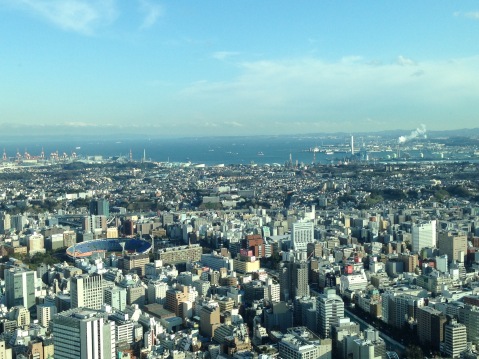
Yokohama
I discovered promenades with colourful newly planted bedding plants and blossom trees just beginning to burst into flower. I went back in time to the 1930s as I walked through the first and third class cabins of the Hikawi Mara, a luxury vessel carrying the wealthy and the poor looking for a new life across the Pacific where, from Seattle, they could continue east to New York by train.
I gazed up at the Grand Hotel where I knew through reading Edith Wharton’s ‘The House of Mirth’ that New York’s society used to frequent.
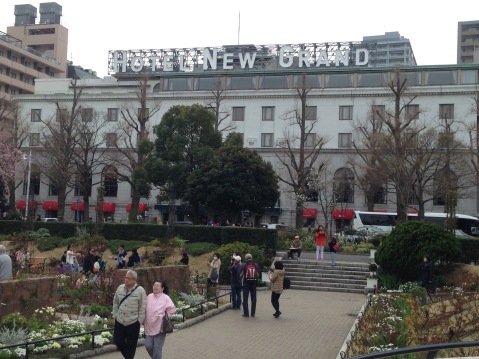
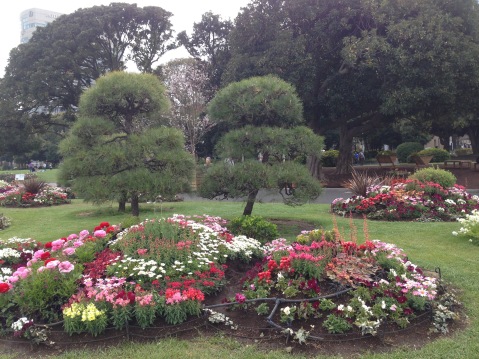
I spent a morning in the Port Museum, tracing the history of this now gigantic port from when it was a lowly fishing village before the Europeans were allowed to trade. I sped up 69 storeys to the top of Landmark Tower and gazed down onto Tokyo and beyond to Mt Fuji.
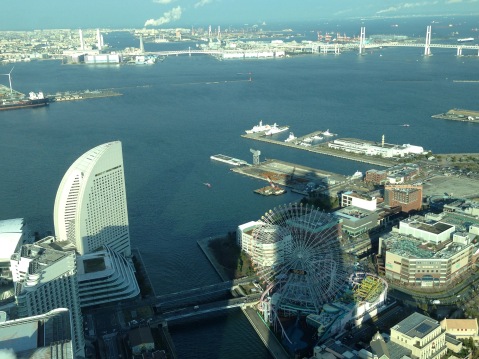
Yokohama port with the shadow of Landmark Tower
I ambled through Monomachi, the popular foreign shopping area of the 1930s, and into China town with its crowded streets and numerous restaurants. One day a Japanese friend took me to Kamakura, the capital of Japan in the 13th century. We went inside the body of the enormous statue of Buddha, visited Zen and Shinto shrines, washed our money in a pool to ensure us wealth and enjoyed the spring flowers and the bamboo forest.
Before coming to Japan we had bought a rail pass which gave us a week’s travel on most of Japan’s railways, including the fast, efficient and smooth Shinkansen with its speeds of up to 320 kph. For each journey you get a ticket with a carriage and seat number. Carriage numbers are written on the platform so when the train stops there is no dashing up and down the platform looking for the right carriage. The door is right there in front of you- so easy.
We travelled to the island of Kyushu, stopping first at Nagasaki, almost a day’s journey from Yokohama. We visited ‘ground zero’ where the atomic bomb vapourised everything and everyone in the area below where the bomb exploded. In the museum we saw horrific pictures of the effects of radiation. Hanging from the ceiling was ‘Fat Man’ – the name the Americans gave to the bomb. It looked small and rather harmless as a few young soldiers, stripped to the waist, loaded it into the plane that would carry it from the base on the Pacific island of Tinian. 
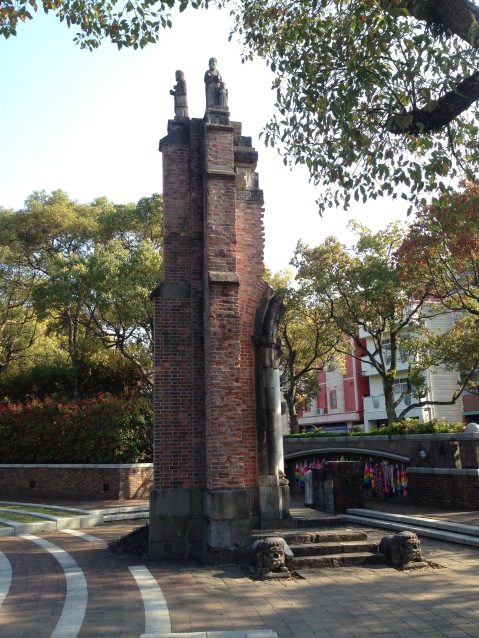
Remains of the cathedral
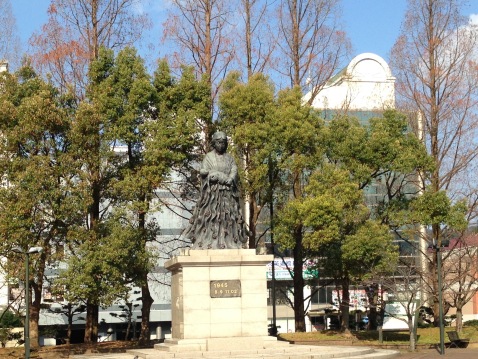
A very different side of Nagasaki is Dejima, the historic fan-shaped trading station in the harbour. For 200 years from the mid 1600s only Chinese and Dutch ships were allowed into Japan and Dejima was the only port. Although Japan was effectively closed to foreigners, books, scientific instruments, knowledge and new ideas filtered in through the port, while goods from all over Japan were exported.
We took the train south to Kagoshima the ‘Naples of Japan’ with its sunny climate and puffing volcano.
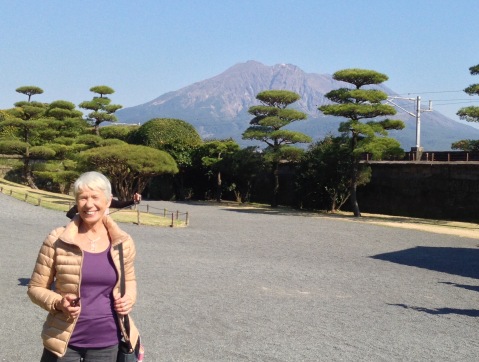
We spent a morning in the Meiji Restoration museum. Watching a reconstruction of the journey of the 20 young Japanese men who went to Europe to learn about industrialization and bring back the information to Japan was fun. They left Japan wearing kimono and sporting top-knots and arrived in London looking like English gentlemen. One of the group never returned to Japan, but went to California and became an oenologist. The Meiji period was more than bringing European ideas to Japan. It was the restoring of the power of the emperor and the end of the Shogunate rule.
We trained up the east coast of Kyushu for a night in Beppu, famed for its onsen, thermal springs. Our traditional hotel had two, one outside looking over the bay and another inside. We were extremely clean and refreshed when we left Beppu, having sat many times on tiny stools and scrubbed ourselves and then soaked in the hot mineral water. It was a memorable experience and made more authentic as we had a room with tatami mats, paper blinds and futons. We were provided with elegant yukata, which some guests, particularly men, wore to breakfast.
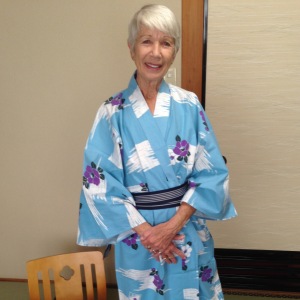
We were sorry to leave Kyushu, famed for its fruit, vegetables, succulent pork and delicious shochu made from sweet potatoes.
Our final destination was Himeji in Kansai prefecture. We chose this historic city as we had been to Kyoto on another visit and Nara would be exceptionally crowded as it was cherry blossom time. The white walls and upturned roofs of the restored 17th century Himeji Castle dominate the centre of the city. Our hotel was well outside the city so we travelled in for the day. Here were our only disappointments in Japan. The gardens and buildings were stunning in the spring sunshine but I had left the camera in the hotel so there are no pictures to show. The other disappointment was the crowds of people in the castle. The five-storey building is made entirely of wood and to reach the top there are narrow wooden stairs going from one floor to the next. It was crowed to the point of being unsafe and we were just pushed forward by the crowd surging behind. When we were already inside, the number of people coming in was limited, but that was too late for us. However, we did enjoy the relative calm of the princess’s palace and the lake and gardens. We spent a good couple of hours wandering through Himeji’s interesting covered shopping market and made a few purchases.
What made our time in Japan so enjoyable?
The people who were always so helpful, smiling and welcoming. Language wasn’t a barrier as most signs are in English and Japanese, and many people speak some English.
The Japanese pride themselves in being efficient and orderly. For a traveller this is a boon. It is easy to find ones way around a station or city as signs are everywhere. It is easy to walk in a city and to cross the road as the traffic is well-ordered. The trains leave and arrive on time. The cities are clean. Japan is a safe and easy country to travel in.
Food does not make my world go round, but the food we had in Japan certainly did. We had noodles far and wide – from lowly ‘one man’ restaurants to ramen in a café in the Sangan Gardens of Kamakura, where the pork broth was divine. We had boards laden with fresh sashimi and plates of spicy dumplings. We enjoyed Japanese breakfasts with fish, meat and pickles and sweet Castella cake in Nagasaki, from a recipe brought by 15th century Portuguese traders. We bought bento on the station to enjoy on the train.
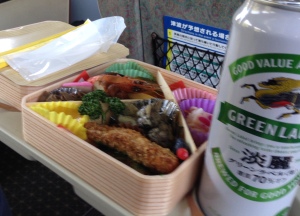
The gastronomic highlight was the dinner we had in our hotel in Himeji. We ate ten courses, each a very small amount, beautifully served, sometimes on china, sometimes pottery, sometimes lacquer.
I believe this kind of meal is called kaiseki (kaichu – kimono pocket, seki – stone). We finished this delicious meal with a tiny scoop of strawberry ice cream and green tea.
Now it’s time to plan another trip to Japan – perhaps to the northern island of Hokkaido.
Comfort

On a previous visit to Japan I experienced “the Japanese toilet” but was too overwhelmed by the buttons, whose instructions I could not make head or tail of, to experience it fully. I only reveled in the welcomingly warm seat. This time around I was more daring, or perhaps they have become more user friendly with standardized symbols in readiness for the 2020 Olympics.
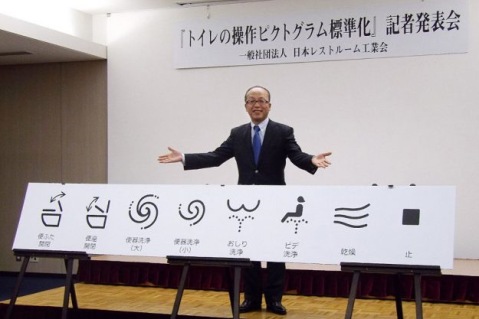
Being more daring (and having an en suite loo) I tried out a range of features: the length and power of the flush; the length and power of the rear wash (spot on target); the bidet wash; the waterfall sound to disguise embarrassing other noises; the blissful warm-air behind dry.
The most thoughtful loo I experienced was the one with the lid that lifted up as the door of the loo opened – of course it shut again as you left. This particular loo had another splendid feature for men who do not appreciate having to lean over and lift the seat before their pee – all they have to do it press a button and up it comes. The ladies in the household will also welcome the unsplashed seat.
Some loos play music of your choice. Others just make a flushing sound to disguise any embarrassing noises coming from the little room. Some have screens to show the temperature of the seat and the force of the flush.
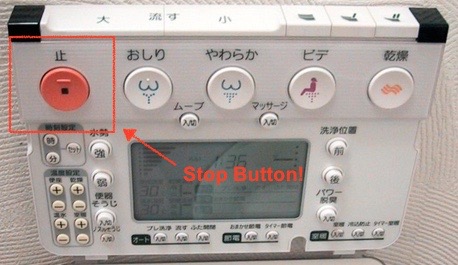
Two weeks travelling in Japan entailed many visits to public ladies loos. They were a delight and child friendly too. There was a low urinal for the little boys and a mini-loo for the girls. Next to the adult loo was a pull down baby seat, so mum was able to do her business, knowing baby was safe. Then she could bring down the change table and make baby clean and happy too.
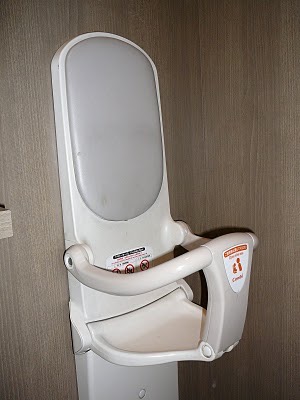
In rural areas there must still be the ever-serviceable squat pan. Somehow, I don’t think these instructions were written by a Japanese person. They would have been more polite.
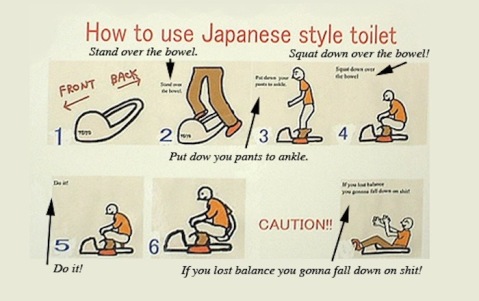
It seems that loos have always been given special consideration in Japan. Here are soldies.
Loo humour is not new either. This one is about 200 years old, from the Edo period.
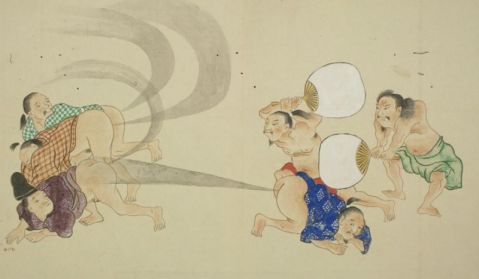
None of the pictures are mine. They are all borrowed from the internet.


























Recent Comments